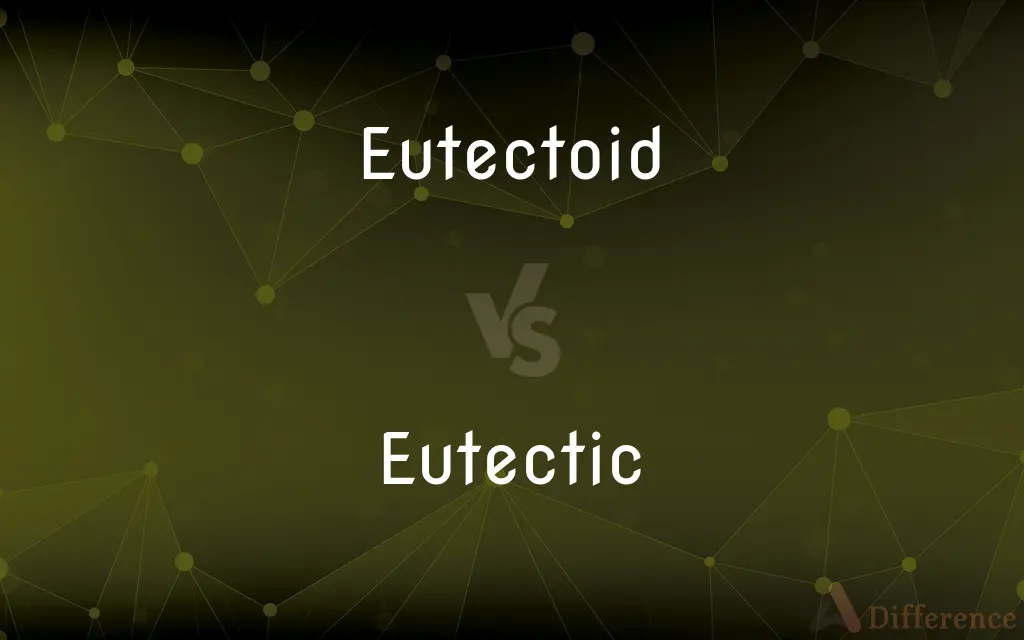Eutectoid vs. Eutectic — What's the Difference?
Edited by Tayyaba Rehman — By Maham Liaqat — Updated on April 4, 2024
Eutectoid reactions involve solid-solid transformations, while eutectic reactions involve liquid-solid phase changes at specific compositions.

Difference Between Eutectoid and Eutectic
Table of Contents
ADVERTISEMENT
Key Differences
Eutectoid and eutectic systems are both crucial in materials science, especially in metallurgy, for understanding how different phases of materials form and transform under specific conditions. A eutectoid reaction involves a single solid phase transforming into two other solid phases at a specific temperature and composition. On the other hand, a eutectic reaction involves a liquid phase transforming into two solid phases upon cooling, also at a specific composition and temperature.
The eutectoid steel, for example, is a classic case where, at the eutectoid point (about 0.76% carbon content and 727°C), austenite transforms into pearlite, a mixture of ferrite and cementite. Whereas, in a eutectic system, such as the Al-Si alloy, the liquid alloy solidifies into a mixture of aluminum and silicon phases at the eutectic composition (12.6% silicon by weight) and temperature (577°C).
The phase change in a eutectoid reaction is purely solid-state, implying that it does not involve melting or solidification, but rather a redistribution of atoms within the solid to form new structures. Conversely, a eutectic reaction transitions directly from liquid to two distinct solid phases without passing through a single solid phase first, indicating a simultaneous solidification of the two phases from the liquid.
Eutectoid transformations are typically slower and occur over a range of temperatures under equilibrium conditions because they involve diffusion of atoms within the solid state. Eutectic transformations, in contrast, can happen rapidly at a single, fixed temperature, as the liquid phase directly solidifies into two solid phases.
Understanding the differences between eutectoid and eutectic reactions is essential for designing alloys with desired mechanical properties, as these reactions dictate the microstructure and, consequently, the material's strength, hardness, and ductility. For instance, manipulating the cooling rate can alter the distance over which atoms diffuse during a eutectoid reaction, while in a eutectic system, the cooling rate can affect the size of the microstructural features.
ADVERTISEMENT
Comparison Chart
Reaction Type
Solid-solid transformation
Liquid to solid transformation
Composition
Specific alloy composition
Specific alloy composition
Temperature
Occurs at a specific temperature
Occurs at a specific temperature
Example Materials
Steel (austenite to pearlite)
Al-Si alloy (liquid to aluminum and silicon)
Phase Transformation
One solid phase transforms into two solids
Liquid phase transforms into two solid phases
Compare with Definitions
Eutectoid
Specific Composition.
The eutectoid composition for steel is approximately 0.76% carbon.
Eutectic
Specific Composition and Temperature.
Eutectic composition for Al-Si alloy is 12.6% Si by weight at 577°C.
Eutectoid
Material Properties.
The mechanical properties of eutectoid steel depend on the pearlite spacing.
Eutectic
Microstructure Formation.
Eutectic structures typically display fine interlocking of two phases.
Eutectoid
Temperature-Dependent.
Eutectoid reactions occur at a specific, invariant temperature.
Eutectic
Liquid-Solid Transformation.
In the Al-Si system, the eutectic reaction forms aluminum and silicon phases from liquid.
Eutectoid
Solid-Solid Transformation.
In eutectoid steel, austenite transforms into pearlite at 727°C.
Eutectic
Material Properties.
Eutectic alloys often have unique properties, such as improved castability or ductility.
Eutectoid
Microstructure.
The microstructure of eutectoid transformations is often lamellar or layered.
Eutectic
Rapid Transformation.
Eutectic reactions can happen quickly, forming distinct microstructures.
Eutectoid
Of or relating to a eutectic mixture or alloy.
Eutectic
Of, relating to, or formed at the lowest possible temperature of solidification for any mixture of specified constituents. Used especially of an alloy whose melting point is lower than that of any other alloy composed of the same constituents in different proportions.
Eutectoid
A eutectic mixture, solution, or alloy.
Eutectic
Exhibiting the constitution or properties of such a solid.
Eutectoid
Describing the phase-change reaction of an alloy in which, on cooling, a single solid phase transforms into two other solid phases.
Eutectic
A eutectic mixture, solution, or alloy.
Eutectoid
An alloy of a composition that undergoes the eutectoid transformation.
Eutectic
The eutectic temperature.
Eutectic
Describing the chemical composition or temperature of a mixture of substances that gives the lowest temperature at which the mixture becomes fully molten. A further requirement is that that temperature is lower than the melting point of any of the pure component substances.
Eutectic
(chemistry) Describing the thermodynamic equilibrium conditions where a liquid coexists with two solid phases.
For a mixture with two components at a fixed pressure, the eutectic reaction can only happen at a fixed chemical composition and temperature, called the eutectic point.
Eutectic
A material that has the composition of a eutectic mixture or eutectic alloy
Eutectic
The temperature of the eutectic point
Eutectic
Of maximum fusibility; - said of an alloy or mixture which has the lowest melting point which it is possible to obtain by the combination of the given components.
Eutectic
A mixture of substances having a composition providing the minimum melting point ofr mixtures of those substances. Called also a eutectic mixture.
Eutectic
A mixture of substances having a minimum melting point
Common Curiosities
How does composition affect eutectoid and eutectic reactions?
Both reactions require precise compositions to occur at their respective invariant temperatures.
What is a eutectic reaction?
A eutectic reaction is a phase change where a liquid transforms directly into two distinct solid phases at a specific composition and temperature.
What is a eutectoid reaction?
A eutectoid reaction is a phase transformation in which a single solid phase decomposes into two different solid phases at a specific temperature and composition.
Can eutectoid and eutectic structures be manipulated?
Yes, by controlling cooling rates and compositions, engineers can alter the microstructures and properties of alloys.
What are the implications of eutectoid transformations in steel?
Eutectoid transformations affect steel's hardness and ductility, crucial for various applications.
Do eutectoid and eutectic reactions only occur in metals?
While common in metals and alloys, these reactions can also occur in ceramics and other materials.
Why are eutectic alloys important in industry?
Eutectic alloys are vital for their unique properties, such as low melting points and good castability, useful in soldering and casting.
What is the difference in microstructure between eutectoid and eutectic alloys?
Eutectoid microstructures often exhibit a layered or lamellar pattern, while eutectic alloys show a fine interlocking of phases.
How are eutectoid and eutectic reactions identified?
Through phase diagrams and microscopic examination of the microstructure.
Why is it important to understand these reactions?
Understanding these reactions allows for the design of materials with specific properties for various applications.
How do cooling rates affect these reactions?
Cooling rates can influence the microstructure and phase distribution in both eutectoid and eutectic systems.
Are eutectoid and eutectic points the same for all materials?
No, each material system has its own specific eutectoid and eutectic compositions and temperatures.
What role does diffusion play in these reactions?
Diffusion is crucial for atom rearrangement in eutectoid reactions and for forming two solid phases in eutectic reactions.
Can the properties of eutectic and eutectoid alloys be customized?
Yes, by adjusting alloy compositions and thermal treatments, customized properties can be achieved.
Can eutectoid reactions be reversed?
Yes, by reheating to above the transformation temperature, but the resulting microstructure may differ.
Share Your Discovery

Previous Comparison
Elder vs. Older
Next Comparison
Confirm vs. ReconfirmAuthor Spotlight
Written by
Maham LiaqatEdited by
Tayyaba RehmanTayyaba Rehman is a distinguished writer, currently serving as a primary contributor to askdifference.com. As a researcher in semantics and etymology, Tayyaba's passion for the complexity of languages and their distinctions has found a perfect home on the platform. Tayyaba delves into the intricacies of language, distinguishing between commonly confused words and phrases, thereby providing clarity for readers worldwide.














































